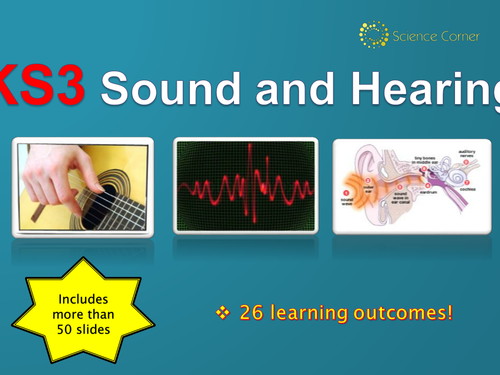








This resource includes a 56 slide PowerPoint presentation, four activity worksheets, a mind map, a short quiz and a 34-question unit test. Everything is ready to be used or easily edited to suit your learners.
• Includes sound clips to bring the learning to life
• Animations have been thoughtfully used to promote participation from lower achieving students and discussion from higher ability ones.
• 26 learning outcomes listed below
By the end of these lessons, pupils will:
1. recognise that sound is made by objects that vibrate
2. define that the frequency of vibration of the source is measured in Hertz (Hz)
3. discuss how sound is made in different musical instruments
4. know that a vibrating source causes the layers of air around it to move
5. discover that sound travels by compressing and expanding the surroundings
6. express that sound travels as a longitudinal wave
7. discover that sound travels best through solids and worst through gases because of the arrangement of the particles
8. explore the relative speed of sound in different mediums
9. explain that sound waves cannot travel through a vacuum because there are no molecules
10. know that sound waves detected by the ear cause the ear drum to vibrate
11. explore the structure of the ear
12. describe how sound is transmitted through the ear to the brain
13. know that different people have different ranges of hearing
14. know that the average human range of hearing is 20 to 20,000 Hz
15. define that loudness is measured in decibels (dB's)
16. discuss that 0 dB is the threshold of hearing and 130 dB's is the threshold of pain whilst 140 dB's causes damage
17. discuss that loud sounds can have permanent and temporary effect on the ear
18. discuss some common causes of ear damage
19. define that noise is unwanted sound
20. discover that a loud sound is produced by a large vibration and vice versa
21. discover that a high pitched sound is produced by a very frequent (quick) vibration and vice versa
22. know that an microphone can change sound to electricity and that this can then be displayed on an oscilloscope
23. know that the wave displayed on an oscilloscope is a transverse wave
24. demonstrate how to identify the amplitude, the wavelength and the frequency of a wave
25. recognise the link between the loudness of the sound and the amplitude of the wave
26. recognise the link between the pitch of the sound and the frequency/wavelength of the wave
Cheers!
Get this resource as part of a bundle and save up to 50%
A bundle is a package of resources grouped together to teach a particular topic, or a series of lessons, in one place.
KS3 Science Mega Bundle - Energy, Forces, Magnetism, Sound, Pressure, Earth, Sun and Moon
Save precious time and money with this KS3 Science Mega Bundle. Includes 7 PowerPoint presentations - over 300 slides in all. Worksheets, activity sheets, and sample test questions are also provided for most lessons. Presentations are thoughtfully animated to allow opportunities for participation and assessment. There are plenty of visual aids and questions to generate curiosity and to help children construct understanding. These resources took me lots of time to prepare. I hope you find them useful. Happy teaching!
KS3 Science Best Sellers, Key Stage 3, Year 7, Year 8
KS3 Science Bundle - Magnetism and Sound
Included in this bundle are 3 of my most popular resources for science teachers on TES. Save 40% with this bundle!
Something went wrong, please try again later.
This is an fantastic resource with a nice layout and a good flow to the lessons - thanks. It is good value for money.
Fabulous resource!!! Great value for the money. A very good powerpoint on Sound and useful worksheets and sample test questions too. Perfect for my students. Well done!
thanks for sharing
Perfect for my better year sevens as well
Report this resourceto let us know if it violates our terms and conditions.
Our customer service team will review your report and will be in touch.